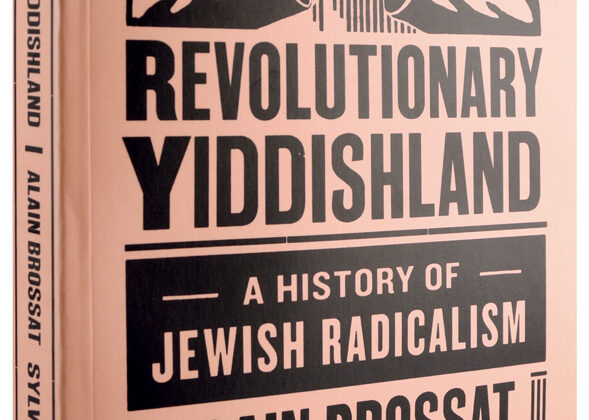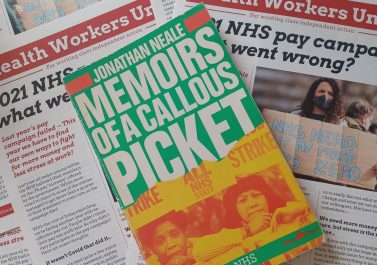By Alain Brossat and Sylvia Klinsberg.
Published by Verso
This is an amazing book and in my review I don’t want to try and summarise it but hopefully to inspire you to read it yourself.
At the beginning of the 20th century of the 11 million Jews world wide, 5 million were living in Russia and with the rise of capitalist industry most of these were proletarians, living and working in appalling conditions. This book traces the development up to the 1950s of the Yiddish speaking working class and particularly its main socialist and revolutionary movements. But in doing this it really gives a vivid picture of the entire European class struggle in this period.
“In more than one respect, the fate of the Yiddishland working class concentrates the fate of the revolutionary workers’ movement of the 20th century, in both its brightest and its darkest colours. Is it accidental that we discover these Yiddishland fighters everywhere that the revolutions brilliantly flared, from the barricades of Lodz to the St |Petersburg soviet of 1905: in Berlin in November 1918, Munich and Budapest in 1919, Poland between the two wars, in the Resistance in France and Belgium and Yugoslavia, and again in the struggle within the concentration camps, from Auschwitz to Vorkuta.”
The authors make clear that this is not the usual history of the Jew as victim, the story promoted by Israel, it is the story of hundreds and thousands of people who dedicated their whole lives to the struggle for socialism and millions more who followed them. It is also a history that is almost invisible because the writers of the USSR empire and of Israel wanted to bury it.
The book is based around interviews the authors conducted in Israel in the 1980s with people who had participated in the three main political trends that existed within the Yiddish working class – the Bund, Poale Zion and the communist movement, all fighting for the emancipation of the working class. Of course over time people switched between these movements that themselves underwent great changes. In particular they all split as a result of the 1917 revolution when people from all the movements joined the barricades and the Bolsheviks.
In talking about the conditions that they grew up in the old militants paint a vivid picture of why Yiddishland was the real catalyst of the eastern European workers movement, both in terms of trade unions and socialist parties as well as things like mutual aid groups, solidarity networks and self defence squads. The interviewees also reject any idea of a ‘community’, making it clear that most of the Yiddish workers toiled in semi-slavery for Jewish bosses who were the first people to establish things like cigarette factories and garment production in Russia. This theme is continued right through. In France in 1945 native French Jews and refugees from the rest of Eastern Europe filled the ranks of the resistance while wealthy Jews collaborated with the Vichy Government.
A great strength of this book is that the authors, while they clearly have an anti-Stalinist, communist outlook, allow all of the voices of the people they interviewed to be heard and understood. Regardless of whether you agree or not with a particular perspective the book makes it possible for you to understand the reasoning and conditions and experiences that led to that perspective. And the three trends – one inclined towards social democracy, one to socialism with the dream of a Jewish homeland and one to the revolutionary overthrow of capital and an international workers emancipation – are at the heart of all the arguments within the Yiddish working class about how to realise their dreams. From the establishment of the Bund at the end of the 19th century right through to the collapse of the Nazi empire, Yiddish militants were in almost constant situations of uprisings, mass workers struggles, revolutions and inter-imperialists wars and throughout, for this section of the working class, there were also the constant waves of anti-Semitic pogroms and state persecution. ( My great grandparents with my two year old grandmother arrived in Glasgow fleeing the pogroms in Krakow)
I think one of the great values of this book for today’s militants is that it looks at a world which was in constant upheaval and in which great political decisions were having to be made every day. How to deal with such conditions that are going to confront us all as capital reduces the world to ruins is a question for us all
The book traces the evolution of the three movements. The differences between them were never straightforward. The question of a Jewish homeland was always under discussion. For some of the communists this was just a utopia left over from old cultural dreams. This whole period saw many Jews assimilating into the broader working class. Not assimilation as the present Zionists like to portray it – an assimilation in the hope that it would hide you from anti-Semitism – but an assimilation that was a natural process for workers who no longer had religious beliefs or any affinity to the ancient cultural practices that went with it.
But thousands of Yiddish speakers – religious and non religious – took part in the two revolutions of 1917, won over not just as workers seeking emancipation but enthused by the Bolshevik’s opposition to chauvinism and a promise of freedom for the small nations of the empire. Lenin and other Bolsheviks discussed at length the problems of the Yiddish workers and agreed that they should be treated as a nation. Initially land was set aside for them in Ukraine and then a Jewish autonomous region was established in the far east of Russia. (later abolished by Stalin)
The rise of Stalin, the resurrection of the Great Russian state saw the crushing not just of the Jewish dream of a homeland but equally the aspirations of many of the other small nations.
A large part of the book necessarily deals with the impact on the Yiddishland people from the degeneration of the revolution. Hundreds of leading Jewish militants were summoned to Moscow and sent to the camps or executed. Here is another important warning for today’s readers. Loyalty to parties, blind belief in leaders, unquestioning acceptance of theories and policies, all this led millions of workers, including the militant Yiddish workers, marching down roads to their own destruction.
For example in 1939 the Polish communist workers, with Yiddish speakers making up half the party leadership had to accept the dissolution of their party on the orders of Stalin. They were told a spy ring had been discovered in the leadership of their party. What they didn’t know was that Stalin had just secretly done a deal with Hitler for the invasion and partition of Poland between Russia and Germany. Stalin didn’t want a communist party there that could mobilise against this invasion.
This was at a time when hundreds of Polish Jews had been fighting against fascism in Spain but here too Stalin’s policies led to their deaths. Stalinist led troops were turned against the Spanish workers occupying factories etc using the argument that the working class was too weak to take power and could only act to support the democratic bourgeoisie, ie the factory owners. Yiddish speakers were on both sides of this battle. Again it was part of Stalin’s global manoeuvring. He had just made pacts with the UK and France and wanted to demonstrate to them that they had nothing to fear – he would not allow revolution anywhere.
Many of the interviewees struggled to understand the source of the defeat in Spain. Some accepted Stalin’s analysis but others began to question their loyalties. What they all knew was that this defeat was to be followed by a bigger war.
A constant feature of the Yiddish workers was that they tended to be far more internationalist, far more global in their outlooks, far less attached to a national conservatism. All across Europe they spoke a common language hich made it far easier to spread news and views. In Spain at one point the only way a Spanish commander can talk to some US volunteers is via a Yiddish soldier.
Fascism, war, the degeneration of the Russian Revolution – from all sides the European militants were being crushed. The story tellers and the authors go to great lengths to talk about this period not in the usual terms of Jews lining up and silently climbing aboard the trains taking them to the concentration camps, but in terms of the continuous resistance they put up. Jewish young women in the Paris resistance who would try to strike up discussion with German soldiers to see if they could be ‘turned’. The Yiddish fighters who went from Spain to fight with the Partisans in Yugoslavia and Bulgaria. The people who organised revolts in the extermination camps themselves. And of course in the Warsaw ghetto. Here several hundred militants met to discuss what to do. They knew that death was only days away and the only thing they had left was their own life. How to use it? They discussed three options – to set the ghetto on fire and die in the flames, to walk out of the ghetto and be machine gunned or to go down fighting with the few weapons they had. The only question was what method of dying might make the greatest impact on the world. They went down fighting. The representative of the Polish Jews in London committed suicide in the street in the West End to add his life to their stand.
Then finally the aftermath of the war. Primo Levi in his book ‘If not now, when’, about Yiddish communist resistance fighters in Belorussia, fighting behind German lines, paints a picture of the terrible dilemma of the socialist Jew at the end of the war and this book allows the speakers to make it even clearer. Where could they go? Western Europe closed its doors to them. Anti-semitism had risen anew in the USSR. Their dreams of workers emancipation and within that their own freedom and security – all of this lay in ruins. The defeat of the Nazis did not mean ‘victory’ for them. They had nowhere to go.
Some of the interviewees, fighters in the French Resistance, or internees in Spain, did make their way home to Russia or Poland only to find themselves accused of being foreign spies and sent to the gulags.
Others, more aware that this was their likely fate had little choice but to head for Palestine. Some went enthusiastically, still thinking that this was to be their ‘socialist’ homeland. The authors rightly say that they ended up in a society that was the polar opposite of what they had all spent their lives fighting for, but as the book says, who can condemn them for that decision in those circumstances.
Between Stalin and Hitler, Yiddishland was obliterated. In Poland, Ukraine and Russia what was left of their old buildings were destroyed and all trace of this people who had been the backbone of the Eastern European workers movement vanished
I can’t begin to do justice to this amazing book. Anyone who is thinking about the problems of building a communist movement today will gain a great deal from reading it.



